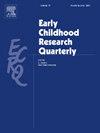屏幕使用和家庭读写能力对儿童接受性词汇发展轨迹的共同影响:一个减少伤害的视角
IF 3.1
1区 教育学
Q1 EDUCATION & EDUCATIONAL RESEARCH
引用次数: 0
摘要
采用三次纵向设计,采用潜生长曲线模型对416名中国学龄前儿童(T1:年龄= 49.64个月,SD = 3.77,女孩占50.7%)2年(2015-2017年)的接受性词汇发展轨迹进行识别,评估屏幕使用、家庭读写环境及其交互作用对儿童接受性词汇发展的影响。结果显示,随着年龄的增长,其发展轨迹呈非线性趋于平稳。HLE和联合媒体参与(JME)正向预测初始接受性词汇水平。屏幕时间对其生长速度有负面影响。高读写能力的家庭环境缓冲了这些不利影响,JME补充了低读写能力家庭的词汇扩展。这些发现强调了HLE在数字时代的重要性,支持了减少伤害的方法来促进学龄前儿童的词汇发展。本文章由计算机程序翻译,如有差异,请以英文原文为准。
The joint effect of screen use and home literacy on children's receptive vocabulary developmental trajectories: A harm reduction perspective
Using a three–time longitudinal design, latent growth curve modeling was used to identify receptive vocabulary developmental trajectories of 416 Chinese preschool children (T1: Mage = 49.64 months, SD = 3.77, 50.7 % girls) over 2 years (2015-2017), assessing the influences of screen use, home literacy environment (HLE), and their interaction on children's receptive vocabulary development. Results showed a non–linear trajectory leveling off with age. HLE and joint media engagement (JME) positively predicted initial receptive vocabulary levels. Screen time negatively affected its growth rate. A rich-literacy home environment buffered these adverse effects, and JME supplemented vocabulary expansion in low-literacy families. These findings underscore the significance of HLE in the digital era, supporting the harm-reduction approach to enhance preschool children's vocabulary development.
求助全文
通过发布文献求助,成功后即可免费获取论文全文。
去求助
来源期刊

Early Childhood Research Quarterly
Multiple-
CiteScore
7.00
自引率
8.10%
发文量
109
期刊介绍:
For over twenty years, Early Childhood Research Quarterly (ECRQ) has influenced the field of early childhood education and development through the publication of empirical research that meets the highest standards of scholarly and practical significance. ECRQ publishes predominantly empirical research (quantitative or qualitative methods) on issues of interest to early childhood development, theory, and educational practice (Birth through 8 years of age). The journal also occasionally publishes practitioner and/or policy perspectives, book reviews, and significant reviews of research. As an applied journal, we are interested in work that has social, policy, and educational relevance and implications and work that strengthens links between research and practice.
 求助内容:
求助内容: 应助结果提醒方式:
应助结果提醒方式:


